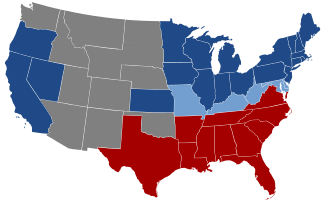More languages
More actions
mNo edit summary Tag: Visual edit |
(Progressive role of Union) Tag: Visual edit |
||
| Line 1: | Line 1: | ||
[[File:Statesian civil war map.svg|thumb|328x328px|Union in blue and Confederacy in red. Light blue states had slavery but remained part of the Union.]] | [[File:Statesian civil war map.svg|thumb|328x328px|Union in blue and Confederacy in red. Light blue states had slavery but remained part of the Union.]] | ||
The '''Statesian Civil War''' was a civil war between the [[Government of the United States of America|Statesian government]] (the Union) and the [[reactionary]] | The '''Statesian Civil War''' was a civil war between the [[Government of the United States of America|Statesian government]] (the Union) and the [[reactionary]] secessionist [[Confederate States of America (1861–1865)|Confederate States of America]] (CSA) from 1861 to 1865. After the war began, 286 out of over 1,000 Statesian officers joined the Confederate Army. Most of the Confederate officers had fought against indigenous nations in [[Settler colonialism|settler colonial]] wars, and the Union Army also attacked the [[Lakota people|Dakota]] in [[State of Minnesota|Minnesota]] and [[Navajo]] in the southwest during the war.<ref name=":0">{{Citation|author=[[Roxanne Dunbar-Ortiz]]|year=2014|title=An Indigenous Peoples' History of the United States|chapter="Indian Country"|pdf=https://www.lcps.org/cms/lib/VA01000195/Centricity/Domain/10601/An%20Indigenous%20Peoples%20History%20of%20the%20United%20States%20Ortiz.pdf|city=Boston, Massachusetts|publisher=Beacon Press|isbn=9780807000403|page=133–138}}</ref> | ||
== Background == | == Background == | ||
In early 1861, several southern states of the [[United States of America|USA]] seceded to form the Confederate States of America. [[Abraham Lincoln]] succeeded [[James Buchanan]] as [[President of the United States]] in March. The CSA seized the army base at Fort Sumter, [[State of South Carolina|South Carolina]] in April 1861, beginning the war.<ref name=":0" /> | In early 1861, several southern states of the [[United States of America|USA]] seceded to form the Confederate States of America. [[Abraham Lincoln]] succeeded [[James Buchanan]] as [[President of the United States]] in March. The CSA seized the army base at Fort Sumter, [[State of South Carolina|South Carolina]] in April 1861, beginning the war.<ref name=":0" /> | ||
== Revolutionary elements == | |||
The Civil War began as a war against separatism, and Lincoln did not initially want to abolish [[slavery]]. Later, when slaves and former slaves entered the Union army, they turned the war into a [[revolution]] against slavery.<ref name=":122">{{Citation|author=[[Domenico Losurdo]]|year=2011|title=Liberalism: A Counter-History|chapter=Crisis of the English and American Models|page=166|publisher=Verso|isbn=9781844676934|lg=https://libgen.rs/book/index.php?md5=5BB3406BC2E64972831A1C00D5D4BFE4|pdf=https://cloudflare-ipfs.com/ipfs/bafykbzacebhsj2yxuoudkhkjp6lzgr5jvgyhu76zxe4gw3d65gpg32a6nded4?filename=Domenico%20Losurdo%2C%20Gregory%20Elliott%20-%20Liberalism_%20A%20Counter-History-Verso%20%282011%29.pdf}}</ref> | |||
== References == | == References == | ||
| Line 9: | Line 12: | ||
<references /> | <references /> | ||
[[Category:History of the USA]] | [[Category:History of the USA]] | ||
[[Category:Slavery]] | |||
Revision as of 14:03, 29 May 2023

The Statesian Civil War was a civil war between the Statesian government (the Union) and the reactionary secessionist Confederate States of America (CSA) from 1861 to 1865. After the war began, 286 out of over 1,000 Statesian officers joined the Confederate Army. Most of the Confederate officers had fought against indigenous nations in settler colonial wars, and the Union Army also attacked the Dakota in Minnesota and Navajo in the southwest during the war.[1]
Background
In early 1861, several southern states of the USA seceded to form the Confederate States of America. Abraham Lincoln succeeded James Buchanan as President of the United States in March. The CSA seized the army base at Fort Sumter, South Carolina in April 1861, beginning the war.[1]
Revolutionary elements
The Civil War began as a war against separatism, and Lincoln did not initially want to abolish slavery. Later, when slaves and former slaves entered the Union army, they turned the war into a revolution against slavery.[2]
References
- ↑ 1.0 1.1 Roxanne Dunbar-Ortiz (2014). An Indigenous Peoples' History of the United States: '"Indian Country"' (pp. 133–138). [PDF] Boston, Massachusetts: Beacon Press. ISBN 9780807000403
- ↑ Domenico Losurdo (2011). Liberalism: A Counter-History: 'Crisis of the English and American Models' (p. 166). [PDF] Verso. ISBN 9781844676934 [LG]
